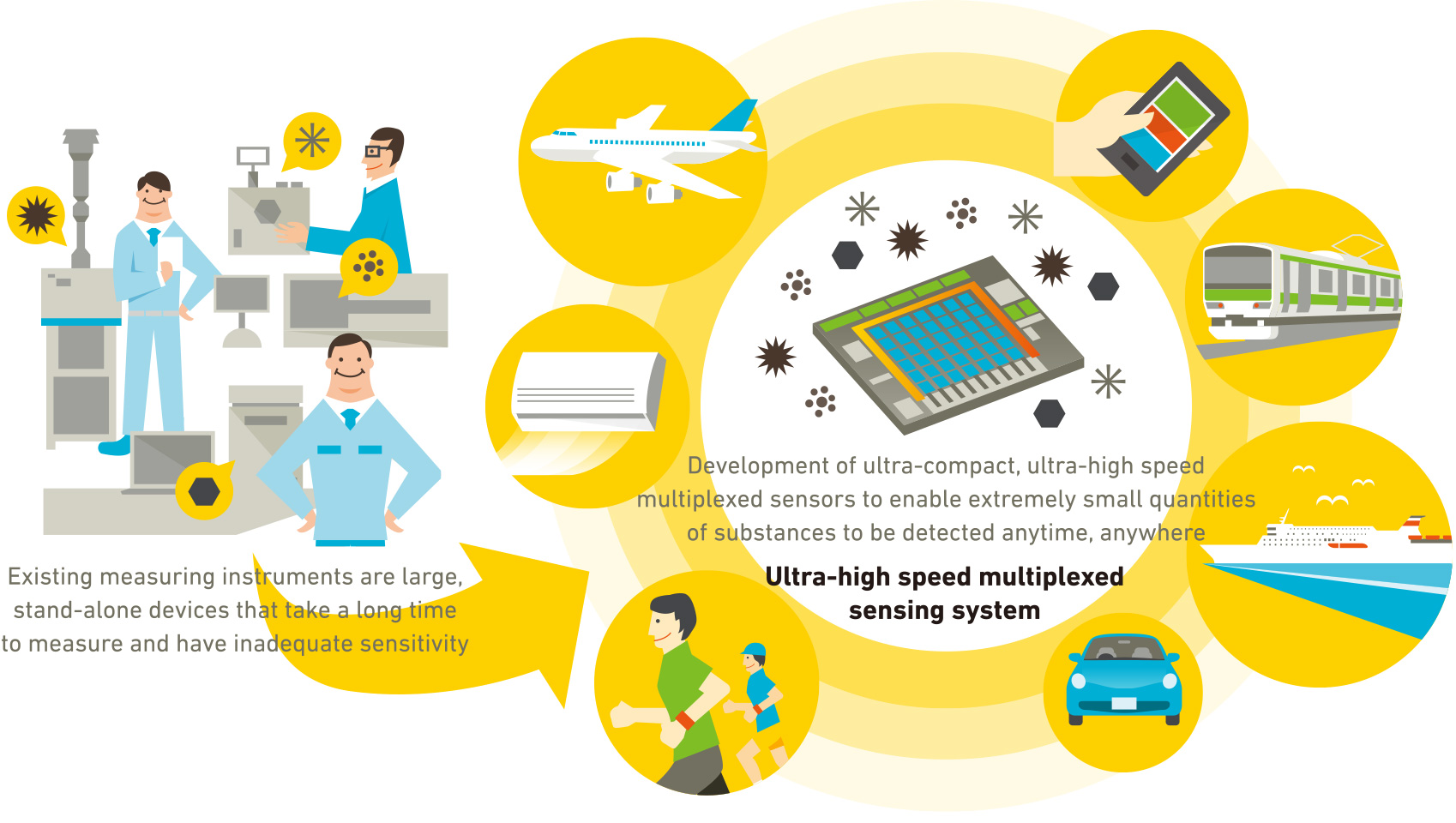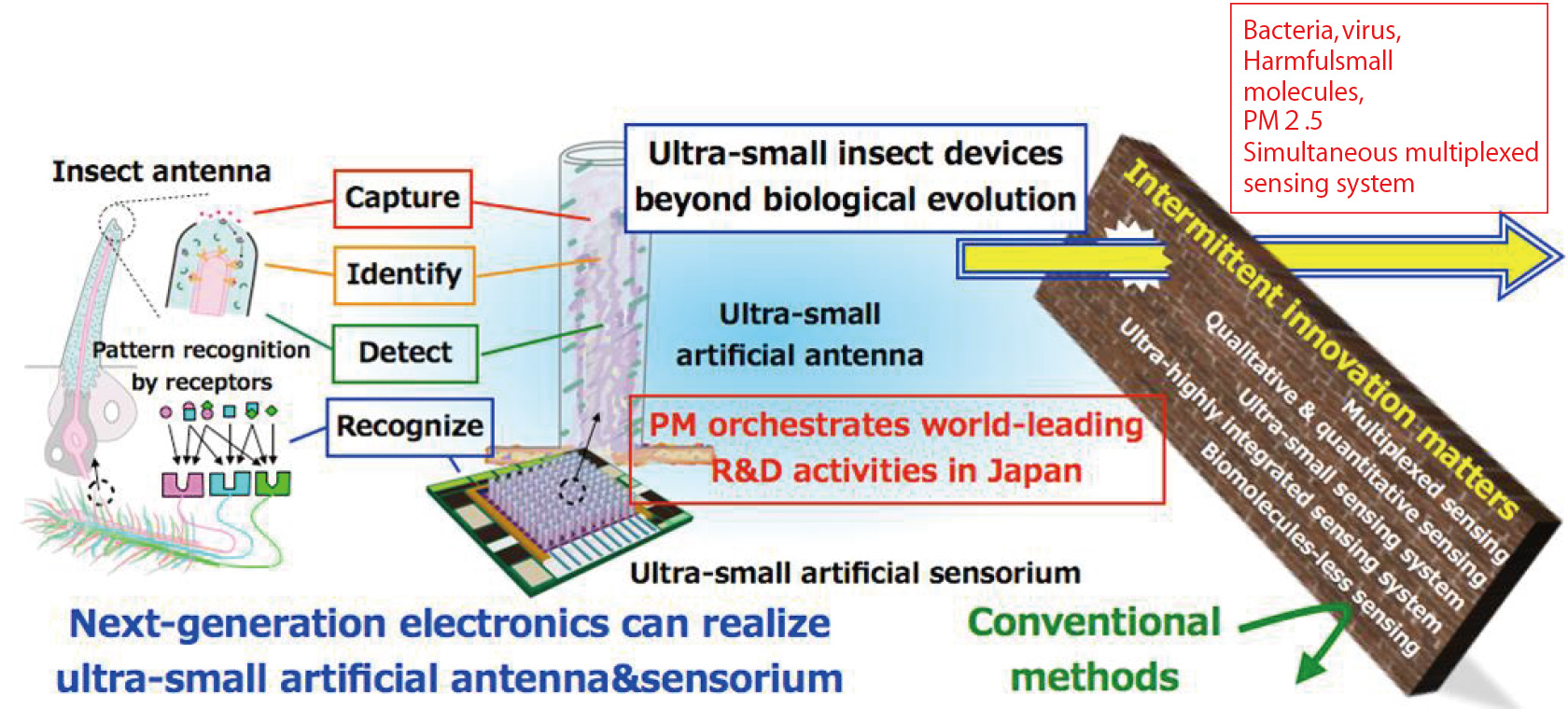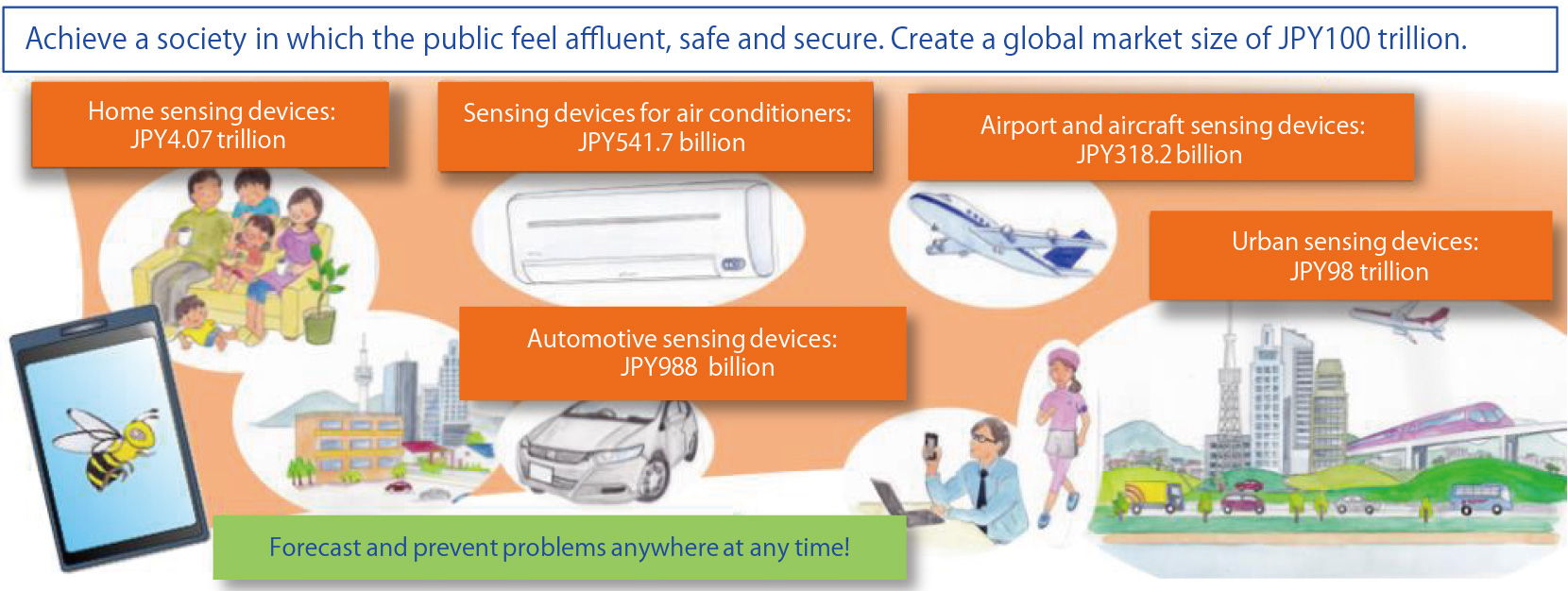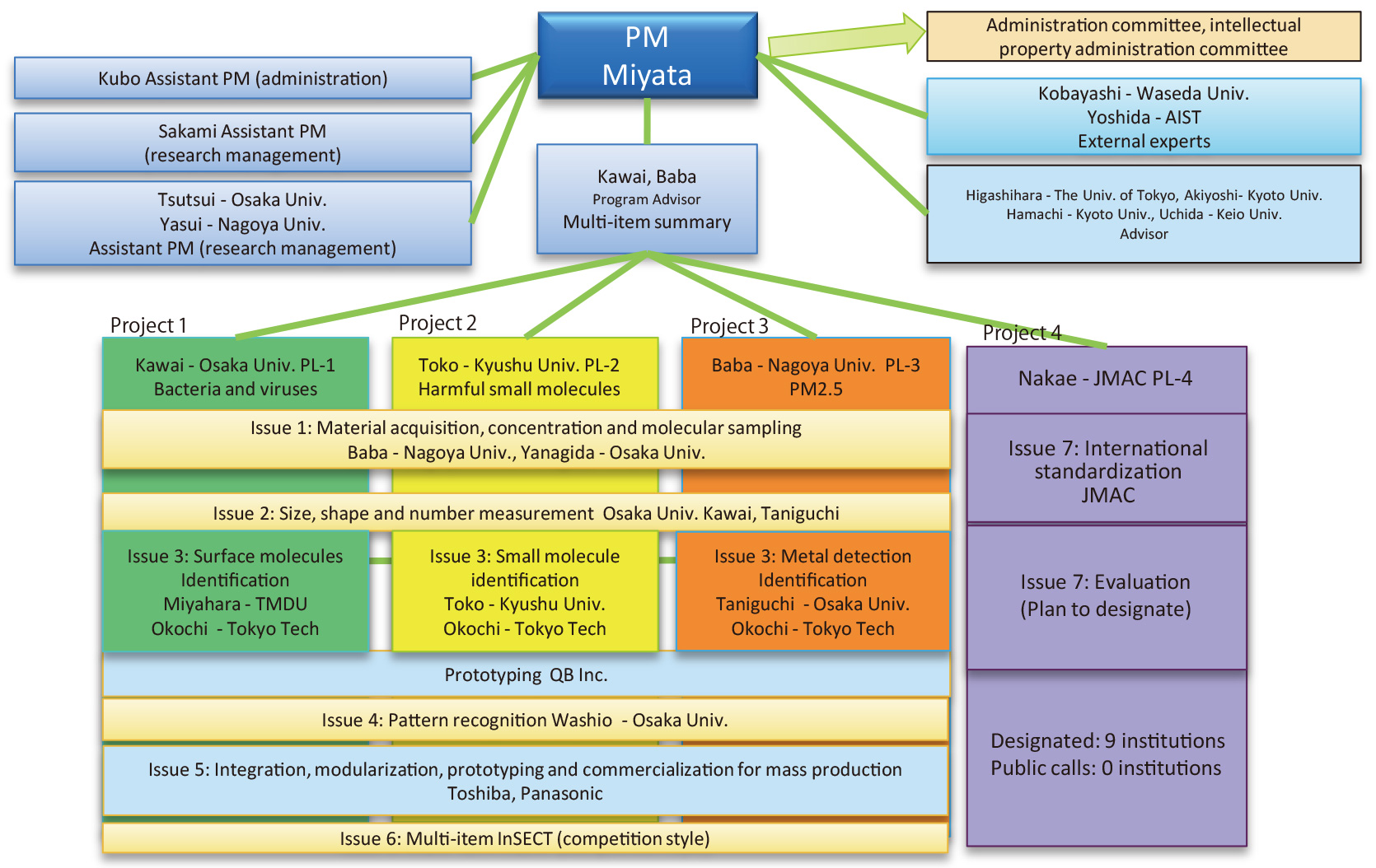
Ultra-high Speed Multiplexed Sensing System Beyond Evolution for the Detection of Extremely Small Quantities of Substances
Program Manager
Reiko Miyata
Reiko Miyata
1982 Graduated from Ochanomizu University
1982 Entered Toray Industries (Basic Research Laboratories)
2001 Senior Researcher at Toray
2004 IP manager at Nagoya University (on external assignment from Toray)
2010 Specially-appointed professor at the Nagoya Univ. Office of Industry Liaison 2014 ImPACT Program Manager
(Cross-appointment between Nagoya Univ. and JST; Effort: 95%)
1982 Entered Toray Industries (Basic Research Laboratories)
2001 Senior Researcher at Toray
2004 IP manager at Nagoya University (on external assignment from Toray)
2010 Specially-appointed professor at the Nagoya Univ. Office of Industry Liaison 2014 ImPACT Program Manager
(Cross-appointment between Nagoya Univ. and JST; Effort: 95%)
Profile
Engaged in comprehensive research and development at Toray Industries with experience of commercialization and research management. Winner of the Technology Award of the Society for Biotechnology, Japan. Engaged in management of industry, academia and government joint research in combined fields at Nagoya Univ.. Maintains a strong network of industry, academia and government specialists. Doctor of Agriculture (Kyoto Univ.).
Engaged in comprehensive research and development at Toray Industries with experience of commercialization and research management. Winner of the Technology Award of the Society for Biotechnology, Japan. Engaged in management of industry, academia and government joint research in combined fields at Nagoya Univ.. Maintains a strong network of industry, academia and government specialists. Doctor of Agriculture (Kyoto Univ.).
What's New
2018/3/19[Press Release]
Overview
All around us, there are dangerous and hazardous substances such as bacteria, viruses, hazardous small molecules, PM2.5 particulate matter, and etc.. To ensure that everyone is able to live a healthy and comfortable life, this program will learn from the outstanding biological capabilities of insects and other creatures and develop an ultra-high speed multiplexed sensing system that surpasses these capabilities by use of nanoelectronics technology which is a Japan’s strength. Installing this system in smartphones, household appliances, automobiles, eyeglasses, wristwatches and other products will make it possible to sense even minute quantities of dangerous and hazardous substances — anytime, anywhere. This will achieve the world’s safest, most secure and most comfortable society and will also lead to the creation of a next-generation electronics industry. 

Disruptive innovation
- Achieve disruptive innovation that can achieve previously impossible ultra fast multiitem sensing systems for trace amounts. To achieve this, assemble Japan’s top R&D capabilities and establishing next generation electronics more advanced than biological evolution.

The Challenges for the PM and the Impact of Success
Overview and background
- Using ultrafine electronics that exceed the exceptional biological capabilities of insects, achieve a simple and effective method for protecting ourselves from the harmful and hazardous substances around us so that everybody can achieve a healthy and comfortable lifestyle. Detect risks of harm and danger quickly and easily and achieve a society in which the public feel safe and secure.
Impact on industry and society in the event of achievement
- By making a simultaneous multi-item sensing system for trace quantities of substances commercially available cheaply, it will be possible to forecast and prevent harm anywhere at any time. Achieve the world’s most pleasant, safe and secure society. Create a next generation industry with a scale of $ 1 trillion through implementation in towns and homes, and big data system related businesses.

Scenario for Success and Achievement Targets
Method of resolution for success (Approach)
- In insects, biological evolution has achieved a wonderful capacity to detect single molecules of substances with high sensitivity and identify tens of thousands of substances using antennae of several millimeters and a perception center system. The aim of this program is to achieve the same thing with a simultaneous multi-item sensing system.
- As an approach that will secure advantage over conventional methods, work on other excellent technologies with highly selective molecular recognition technologies suitable for each target substance, compare and select several methods through competition and collaboration, with management and elimination using the stage-gate method. Confer these molecular recognition technology functions to the common device substrate and invent the optimal Insect device.
Achievement targets and risks
- In addition, realize socially implementable ultra compact devices (Insect devices) with an evaluation system, and commercialize systems that can sense trace quantities of harmful or dangerous substances anywhere at any time (ultimate target: Detection of a single molecule with measurement time of 5 minutes).
- By breaking through the fundamental technological barriers in advanced micromachining processes and electronics, establish a role model for the next generation electronics industry and create an industry with high international competitiveness.
Overall R&D Program Structure Created by the PM
 Further application fields: Create a next generation industry with a scale of 100 trillion yen through implementation in towns and homes, and big data system related businesses.
Further application fields: Create a next generation industry with a scale of 100 trillion yen through implementation in towns and homes, and big data system related businesses.Implementation Structure as Assembled by the PM
Keys of the implementation structure
- Work on other excellent technologies with highly selective molecular recognition technologies suitable for each target substance, compare and select several methods through competition and collaboration, with management and elimination using the stage-gate method. Confer these molecular recognition technology functions to the common device substrate and invent the optimal InSECT device.
Approach to selection of institutions
- During the building phase, hold workshops to understand the technology. Then hold several study meetings with the workshop members and select Japan’s top level molecule identification technologies, highly selective materials and ultrafine electronics technologies suitable for each target material.
- After the PM has nominated several people in the workshops and study meetings, the nominees will submit proposals in a competition format.
- The technologies employed will be revised every 6 months to a year through competition to select the truly top level technologies.
- To achievement the target of Issue 6, it is important to be able to develop devices capable of measuring multiple items simultaneously. The PM will publish the specific results required and specifications and request proposals through competitive public invitation.

Organization
The Cabinet Office
ImPACT: Impulsing Paradigm Change through Disruptive Technologies Program
ImPACT Program Manager
Reiko Miyata
ImPACT: Impulsing Paradigm Change through Disruptive Technologies Program
ImPACT Program Manager
Reiko Miyata
Associate Program Manager
Satoshi Sakami
Satoshi Sakami
Associate Program Manager
Makusu Tsutsui
Makusu Tsutsui
Associate Program Manager
Takao Yasui
Takao Yasui
Associate Program Manager
Rui Yatabe
Rui Yatabe

